The benefits of licorice are many, from supporting adrenal function to fighting allergies. Here’s how to find it, eat it, and heal with it.
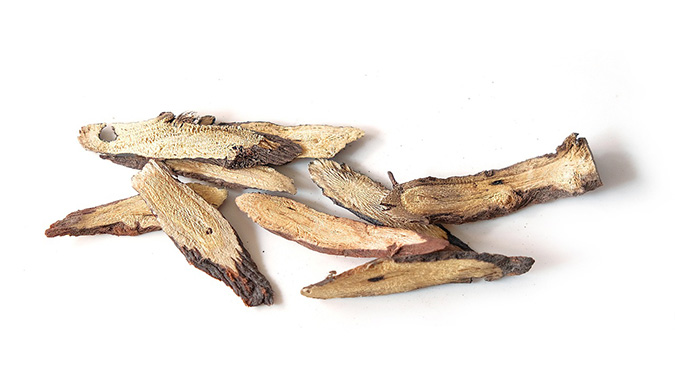
Image by Husky Kuma from Pixabay
17+ Benefits of Licorice: A Sweet Solution for Sore Throats, Digestive Issues, Allergies, and More!
- Botanical Name: Glycyrrhiza glabra
- Family: Fabaceae (pea)
- Other Common Names: Sweet root
- Parts Used: Roots
- Energetics: Moist
- Thermal Properties: Neutral
- Actions: Adaptogen (adrenal), antibacterial, anticatarrhal, antidepressive, anti-inflammatory, antitussive, antiviral, anodyne, aperient, demulcent, expectorant, hepatoprotective, immune stimulant, pectoral, tonic (adrenal)
- Taste: Sweet
- Plant Uses: Licorice has a variety of uses. It soothes all parts of the digestive tract, supports adrenal function, soothes coughs, and breaks up congestions. Licorice also has a strong antihistamine effect, is a broad spectrum antiviral, and protects the liver. Licorice is commonly added to herbal formulas as a synergist and harmonizer. Aside from medicinal uses, licorice is also used to flavor foods and drinks.
- Plant Preparations: Licorice can be used in powdered form topically or in capsules. It can be used in infusions, decoctions, and tinctures. The root can be used as a tooth cleaner, and the softened root can be sucked on to relieve a sore throat.
- Toxicities/Warnings: Licorice is generally considered non-toxic, as long as it is not taken in excessive doses or for periods over 6 weeks. Licorice is not advised for pregnant women, or for those taking certain medications.
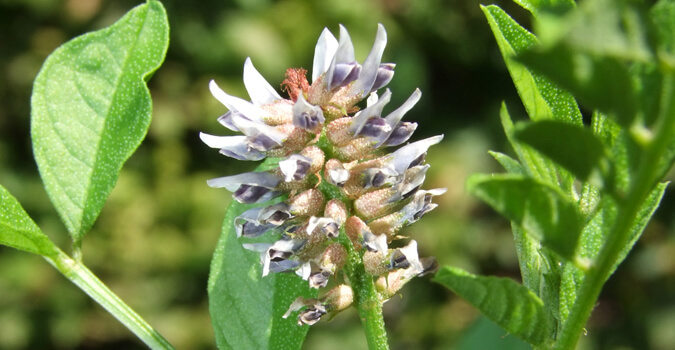
Photo by Pharaoh han [CC BY-SA 3.0 (https://creativecommons.org/licenses/by-sa/3.0)]
Introduction
Licorice is one of the most widely used herbs in the world. It has a strong presence in Chinese and Ayurvedic traditional medicine, and was used by the ancient Greeks and Egyptians. In fact, it’s been used in foods and medicines by virtually all peoples that have had access to it for the last several thousand years.
Licorice also has a long history in flavoring foods, and the scientific naming alludes to this. Glycirrhiza means “sweet root.” The sweet taste comes from a saponin, glycyrrhizin, which is said to be 50 times sweeter than sugar. No doubt, this is a key contributing factor to its use in candies and deserts.
You May Also Enjoy:
“15 Natural Antibiotic Alternatives”
Whether due to its widespread use as a medicinal herb, or as a side-effect of its use in the food industry, modern science eventually took notice of the herb and began conducting experiments. What they discovered confirmed many traditional uses and expanded on others. In the 1980s, licorice was used as a major anti-ulcer drug. In recent years, its antiviral properties have come more into focus.
Whether you use licorice as a food or a medicine, it has a lot to offer.
Benefits of Licorice
- The Great Harmonizer: Licorice is a potent synergizer and harmonizer of other herbs.1)Forêt, Rosalee De La. “Licorice Monograph.” HerbMentor. Accessed April 12, 2019. https://herbmentor.learningherbs.com/herb/licorice/.
- Sweet-Tasting Medicine: It’s easy to get kids and reluctant adults to take herbal medicines when you mix in a little licorice.
- Heartburn and Acid Reflux Relief: Licorice soothes and coats the esophagus, protecting it from stomach acid.2)”8 Medicinal Ways to Use Licorice Root to Help Fight Stomach Ulcers, Colds and the Flu.” Mercola.com. Accessed April 12, 2019. https://articles.mercola.com/sites/articles/archive/2016/03/21/licorice-root-uses.aspx.3)Axe, Josh. “Licorice Root Benefits: Adrenal Fatigue, Leaky Gut & More.” Dr. Axe. July 27, 2018. Accessed April 12, 2019. https://draxe.com/licorice-root/.
- Leaky Gut: The demulcent properties of licorice can protect the gut, allowing it to heal.4)Axe, Josh. “Licorice Root Benefits: Adrenal Fatigue, Leaky Gut & More.” Dr. Axe. July 27, 2018. Accessed April 12, 2019. https://draxe.com/licorice-root/.
- Adrenal Support: Licorice has a tonic and adaptogen effect on the adrenals. Use it to get your energy back, even in times of stress.5)Buhner, Stephen Harrod. Herbal Antivirals: Natural Remedies for Emerging and Resistant Viral Infections. Pownal, VT: Storey, 2013.6)Bone, Kerry, and Simon Mills. Principles and Practice of Phytotherapy Modern Herbal Medicine. Edinburgh: Churchill Livingstone, Elsevier, 2013.7)”8 Medicinal Ways to Use Licorice Root to Help Fight Stomach Ulcers, Colds and the Flu.” Mercola.com. Accessed April 12, 2019. https://articles.mercola.com/sites/articles/archive/2016/03/21/licorice-root-uses.aspx.8)Forêt, Rosalee De La. “Licorice Monograph.” HerbMentor. Accessed April 12, 2019. https://herbmentor.learningherbs.com/herb/licorice/.
- Antimicrobial: Licorice is an excellent broad-spectrum antiviral, and has good antibacterial properties, as well.9)Zhou, Jun-Xian, Markus Braun, Pille Wetterauer, Bernhard Wetterauer, and Michael Wink. “Antioxidant, Cytotoxic, and Antimicrobial Activities of Glycyrrhiza Glabra L., Paeonia Lactiflora Pall., and Eriobotrya Japonica (Thunb.) Lindl. Extracts.” Medicines 6, no. 2 (2019): 43. doi:10.3390/medicines6020043.10)Buhner, Stephen Harrod. Herbal Antivirals: Natural Remedies for Emerging and Resistant Viral Infections. Pownal, VT: Storey, 2013.11)Bone, Kerry, and Simon Mills. Principles and Practice of Phytotherapy Modern Herbal Medicine. Edinburgh: Churchill Livingstone, Elsevier, 2013.12)”8 Medicinal Ways to Use Licorice Root to Help Fight Stomach Ulcers, Colds and the Flu.” Mercola.com. Accessed April 12, 2019. https://articles.mercola.com/sites/articles/archive/2016/03/21/licorice-root-uses.aspx.13)Axe, Josh. “Licorice Root Benefits: Adrenal Fatigue, Leaky Gut & More.” Dr. Axe. July 27, 2018. Accessed April 12, 2019. https://draxe.com/licorice-root14)Forêt, Rosalee De La. “Licorice Monograph.” HerbMentor. Accessed April 12, 2019. https://herbmentor.learningherbs.com/herb/licorice
- Immune Booster: Strengthen your immune system and fight off any pathogens that got past licorice’s antimicrobial properties.15)[Buhner, Stephen Harrod. Herbal Antivirals: Natural Remedies for Emerging and Resistant Viral Infections. Pownal, VT: Storey, 2013.16)Bone, Kerry, and Simon Mills. Principles and Practice of Phytotherapy Modern Herbal Medicine. Edinburgh: Churchill Livingstone, Elsevier, 2013.17)”8 Medicinal Ways to Use Licorice Root to Help Fight Stomach Ulcers, Colds and the Flu.” Mercola.com. Accessed April 12, 2019. https://articles.mercola.com/sites/articles/archive/2016/03/21/licorice-root-uses.aspx.18)Axe, Josh. “Licorice Root Benefits: Adrenal Fatigue, Leaky Gut & More.” Dr. Axe. July 27, 2018. Accessed April 12, 2019. https://draxe.com/licorice-root/.19)Forêt, Rosalee De La. “Licorice Monograph.” HerbMentor. Accessed April 12, 2019. https://herbmentor.learningherbs.com/herb/licorice/.
- Throat Soother: Licorice can quiet coughs and relieve a sore throat.20)Bone, Kerry, and Simon Mills. Principles and Practice of Phytotherapy Modern Herbal Medicine. Edinburgh: Churchill Livingstone, Elsevier, 2013.21)”8 Medicinal Ways to Use Licorice Root to Help Fight Stomach Ulcers, Colds and the Flu.” Mercola.com. Accessed April 12, 2019. https://articles.mercola.com/sites/articles/archive/2016/03/21/licorice-root-uses.aspx.22)Forêt, Rosalee De La. “Licorice Monograph.” HerbMentor. Accessed April 12, 2019. https://herbmentor.learningherbs.com/herb/licorice/.
- Women’s Health: Ease the symptoms of PMS and menopause.23)Bone, Kerry, and Simon Mills. Principles and Practice of Phytotherapy Modern Herbal Medicine. Edinburgh: Churchill Livingstone, Elsevier, 2013.24)Axe, Josh. “Licorice Root Benefits: Adrenal Fatigue, Leaky Gut & More.” Dr. Axe. July 27, 2018. Accessed April 12, 2019. https://draxe.com/licorice-root/.
- Relieve Pain: Licorice has a pain-relieving effect both internally and externally.25)Buhner, Stephen Harrod. Herbal Antivirals: Natural Remedies for Emerging and Resistant Viral Infections. Pownal, VT: Storey, 2013.26)Axe, Josh. “Licorice Root Benefits: Adrenal Fatigue, Leaky Gut & More.” Dr. Axe. July 27, 2018. Accessed April 12, 2019. https://draxe.com/licorice-root/.
- Soothe and Heal Digestive Issues: Get relief from stomach ulcers, Irritable Bowel Syndrome, and a number of other digestive problems.27)Bone, Kerry, and Simon Mills. Principles and Practice of Phytotherapy Modern Herbal Medicine. Edinburgh: Churchill Livingstone, Elsevier, 2013.28)Hoffmann, David. Medical Herbalism: The Science and Practice of Herbal Medicine. Rochester, VT: Healing Arts Press, 2003.29)”8 Medicinal Ways to Use Licorice Root to Help Fight Stomach Ulcers, Colds and the Flu.” Mercola.com. Accessed April 12, 2019. https://articles.mercola.com/sites/articles/archive/2016/03/21/licorice-root-uses.aspx.30)Forêt, Rosalee De La. “Licorice Monograph.” HerbMentor. Accessed April 12, 2019. https://herbmentor.learningherbs.com/herb/licorice/.
- Reduce Inflammation: Calm the irritated tissues of the body with licorice.31)Axe, Josh. “Licorice Root Benefits: Adrenal Fatigue, Leaky Gut & More.” Dr. Axe. July 27, 2018. Accessed April 12, 2019. https://draxe.com/licorice-root
- Gentle Laxative: Licorice can help to relieve constipation and restore normal bowel movements.32)Bone, Kerry, and Simon Mills. Principles and Practice of Phytotherapy Modern Herbal Medicine. Edinburgh: Churchill Livingstone, Elsevier, 2013.33)Hoffmann, David. Medical Herbalism: The Science and Practice of Herbal Medicine. Rochester, VT: Healing Arts Press, 2003.34)”8 Medicinal Ways to Use Licorice Root to Help Fight Stomach Ulcers, Colds and the Flu.” Mercola.com. Accessed April 12, 2019. https://articles.mercola.com/sites/articles/archive/2016/03/21/licorice-root-uses.aspx.35)Forêt, Rosalee De La. “Licorice Monograph.” HerbMentor. Accessed April 12, 2019. https://herbmentor.learningherbs.com/herb/licorice/.
- Liver Protector: Use licorice to protect your liver from chronic hepatitis, cirrhosis, and chemical damage to the liver, and to heal after exposure.36)Bone, Kerry, and Simon Mills. Principles and Practice of Phytotherapy Modern Herbal Medicine. Edinburgh: Churchill Livingstone, Elsevier, 2013.37)Hoffmann, David. Medical Herbalism: The Science and Practice of Herbal Medicine. Rochester, VT: Healing Arts Press, 2003.
- Congestion Clearer: Licorice helps to loosen excess mucous in the respiratory tract.38)Bone, Kerry, and Simon Mills. Principles and Practice of Phytotherapy Modern Herbal Medicine. Edinburgh: Churchill Livingstone, Elsevier, 2013.39)Hoffmann, David. Medical Herbalism: The Science and Practice of Herbal Medicine. Rochester, VT: Healing Arts Press, 2003.
- Mouth Ulcers: Apply licorice powder directly to mouth lesions to sooth the pain and battle invading micro-organisms.40)Bone, Kerry, and Simon Mills. Principles and Practice of Phytotherapy Modern Herbal Medicine. Edinburgh: Churchill Livingstone, Elsevier, 2013.
- Reduce Allergic Reactions. Licorice has a strong antihistamine effect. It can be also be used with asthma and eczema.41)Martin, Brett R., Gaurav Reshamwala, and Melanie Short. “Treatment of a Woman With Glycyrrhiza Glabra for Acute Sinusitis: A Case Report.” Journal of Chiropractic Medicine 17, no. 4 (2018): 268-74. doi:10.1016/j.jcm.2018.04.005.42)Bone, Kerry, and Simon Mills. Principles and Practice of Phytotherapy Modern Herbal Medicine. Edinburgh: Churchill Livingstone, Elsevier, 2013.43)Fouladi, Saloomeh, Mohsen Masjedi, Mazdak Ganjalikhani Hakemi, and Nahid Eskandari. 2019. “The Review of in Vitro and in Vivo Studies over the Glycyrrhizic Acid As Natural Remedy Option for Treatment of Allergic Asthma”. Iranian Journal of Allergy, Asthma and Immunology18 (1), 1-11. http://ijaai.tums.ac.ir/index.php/ijaai/article/view/1740.
- Radiation Protection: Yes, licorice can even help to protect you from the effects of radiation exposure.44)Buhner, Stephen Harrod. Herbal Antivirals: Natural Remedies for Emerging and Resistant Viral Infections. Pownal, VT: Storey, 2013.
Medicinal Properties of Licorice
Licorice has a large number of useful medicinal properties. Interestingly, one of the most valued properties has to do with how it affects other herbs, rather than how it affects us.
Licorice is called the great harmonizer. It has a way of helping other herbs work together while minimizing side effects. Licorice has a strong synergistic effect with other herbs and is used more often in combination than alone.45)Buhner, Stephen Harrod. Herbal Antivirals: Natural Remedies for Emerging and Resistant Viral Infections. Pownal, VT: Storey, 2013.46)Forêt, Rosalee De La. “Licorice Monograph.” HerbMentor. Accessed April 12, 2019. https://herbmentor.learningherbs.com/herb/licorice/.
You May Also Enjoy:
“10 Easy Ways to Take Care of Your Teeth … Naturally!”
Licorice is also a broad-spectrum antiviral that works through a number of mechanisms. It directly inactivates some viruses, keeps others from multiplying, and prevents still others from entering your cells. It is effective against many viruses, including HIV, herpes, hepatitis, tuberculosis, SARS, influenza, viral respiratory infections, pneumonia, tuberculosis, retroviruses, viral encephalitis, and the common cold.47)Zhou, Jun-Xian, Markus Braun, Pille Wetterauer, Bernhard Wetterauer, and Michael Wink. “Antioxidant, Cytotoxic, and Antimicrobial Activities of Glycyrrhiza Glabra L., Paeonia Lactiflora Pall., and Eriobotrya Japonica (Thunb.) Lindl. Extracts.” Medicines 6, no. 2 (2019): 43. doi:10.3390/medicines6020043.48)Buhner, Stephen Harrod. Herbal Antivirals: Natural Remedies for Emerging and Resistant Viral Infections. Pownal, VT: Storey, 2013.49)Bone, Kerry, and Simon Mills. Principles and Practice of Phytotherapy Modern Herbal Medicine. Edinburgh: Churchill Livingstone, Elsevier, 2013.50)Hoffmann, David. Medical Herbalism: The Science and Practice of Herbal Medicine. Rochester, VT: Healing Arts Press, 2003.51)”8 Medicinal Ways to Use Licorice Root to Help Fight Stomach Ulcers, Colds and the Flu.” Mercola.com. Accessed April 12, 2019. https://articles.mercola.com/sites/articles/archive/2016/03/21/licorice-root-uses.aspx.52)Forêt, Rosalee De La. “Licorice Monograph.” HerbMentor. Accessed April 12, 2019. https://herbmentor.learningherbs.com/herb/licorice/.
The main antiviral component in licorice is glycyrrhizin. All species of licorice contain glycyrrhizin in varying quantities, and can be used medicinally.53)Buhner, Stephen Harrod. Herbal Antivirals: Natural Remedies for Emerging and Resistant Viral Infections. Pownal, VT: Storey, 2013. Cultivated licorice (Glycyrrhizi glabra) contains the highest concentration of glycyrrhizin, however Chinese licorice (Glycyrrhizi uralensis) is also commonly used. American licorice (Glycyrrhzi lepadita) has a lower amount of glycyrrhizin, though it is still favored by many.
Glycyrrhizin takes 4-8 hours to reach its maximum levels in the body, after being ingested. It then remains in the body for 72 hours, though most is removed after 24 hours. In short, glycyrrhizin is good at remaining in the body, helping it to keep working long after it is consumed.54)Buhner, Stephen Harrod. Herbal Antivirals: Natural Remedies for Emerging and Resistant Viral Infections. Pownal, VT: Storey, 2013.
In the case of cold sores and other mouth ulcers, licorice can be applied directly in its powder form, or as a cream or salve.55)Bone, Kerry, and Simon Mills. Principles and Practice of Phytotherapy Modern Herbal Medicine. Edinburgh: Churchill Livingstone, Elsevier, 2013. It can be used in the care of teeth and gums to prevent bacterial actions and the formation of biofilm.56)Buhner, Stephen Harrod. Herbal Antivirals: Natural Remedies for Emerging and Resistant Viral Infections. Pownal, VT: Storey, 2013. For internal infections, it can be taken through a number of applications, as listed below. Licorice is also antibacterial and has immune-stimulating properties.57)Zhou, Jun-Xian, Markus Braun, Pille Wetterauer, Bernhard Wetterauer, and Michael Wink. “Antioxidant, Cytotoxic, and Antimicrobial Activities of Glycyrrhiza Glabra L., Paeonia Lactiflora Pall., and Eriobotrya Japonica (Thunb.) Lindl. Extracts.” Medicines 6, no. 2 (2019): 43. doi:10.3390/medicines6020043.58)Buhner, Stephen Harrod. Herbal Antivirals: Natural Remedies for Emerging and Resistant Viral Infections. Pownal, VT: Storey, 2013.59)Bone, Kerry, and Simon Mills. Principles and Practice of Phytotherapy Modern Herbal Medicine. Edinburgh: Churchill Livingstone, Elsevier, 2013.60)”8 Medicinal Ways to Use Licorice Root to Help Fight Stomach Ulcers, Colds and the Flu.” Mercola.com. Accessed April 12, 2019. https://articles.mercola.com/sites/articles/archive/2016/03/21/licorice-root-uses.aspx.61)Axe, Josh. “Licorice Root Benefits: Adrenal Fatigue, Leaky Gut & More.” Dr. Axe. July 27, 2018. Accessed April 12, 2019. https://draxe.com/licorice-root/.62)Forêt, Rosalee De La. “Licorice Monograph.” HerbMentor. Accessed April 12, 2019. https://herbmentor.learningherbs.com/herb/licorice/.
You May Also Enjoy:
“9 Simple, Effective Probiotics You Can Make at Home”
“19 Uses for Spent Coffee Grounds in Your Home and Garden”
“7 Ways to Use Pine Trees for Food and Medicine, Year-round”
Licorice is commonly taken for all manner of digestive problems. Whether you are suffering from ulcers, leaky gut, an irritable bowel disease, constipation, heartburn, acid reflux, or other gastrointestinal discomforts, licorice can help.63)Bone, Kerry, and Simon Mills. Principles and Practice of Phytotherapy Modern Herbal Medicine. Edinburgh: Churchill Livingstone, Elsevier, 2013.64)Hoffmann, David. Medical Herbalism: The Science and Practice of Herbal Medicine. Rochester, VT: Healing Arts Press, 2003.65)”8 Medicinal Ways to Use Licorice Root to Help Fight Stomach Ulcers, Colds and the Flu.” Mercola.com. Accessed April 12, 2019. https://articles.mercola.com/sites/articles/archive/2016/03/21/licorice-root-uses.aspx.66)Axe, Josh. “Licorice Root Benefits: Adrenal Fatigue, Leaky Gut & More.” Dr. Axe. July 27, 2018. Accessed April 12, 2019. https://draxe.com/licorice-root/.67)Forêt, Rosalee De La. “Licorice Monograph.” HerbMentor. Accessed April 12, 2019. https://herbmentor.learningherbs.com/herb/licorice/. Benefits of licorice include a demulcent nature that helps to sooth and protect irritated and inflamed tissues. It reduces stomach secretions, which eases the pain of ulcers.68)Buhner, Stephen Harrod. Herbal Antivirals: Natural Remedies for Emerging and Resistant Viral Infections. Pownal, VT: Storey, 2013. Licorice also has antibacterial properties against ulcer-causing Heliobacter pyloribacteria.69)Forêt, Rosalee De La. “Licorice Monograph.” HerbMentor. Accessed April 12, 2019. https://herbmentor.learningherbs.com/herb/licorice/.
The protective effects of licorice are not limited to the digestive tract. Licorice is also an excellent liver protective, and in some places it can be taken intravenously for this purpose. It can be used to protect and assist healing in cases of cirrhosis, hepatitis, and chemical exposure.70)Bone, Kerry, and Simon Mills. Principles and Practice of Phytotherapy Modern Herbal Medicine. Edinburgh: Churchill Livingstone, Elsevier, 2013.71)Hoffmann, David. Medical Herbalism: The Science and Practice of Herbal Medicine. Rochester, VT: Healing Arts Press, 2003. Licorice also has a general protective effect on the body, against the effects of radiation exposure.72)Buhner, Stephen Harrod. Herbal Antivirals: Natural Remedies for Emerging and Resistant Viral Infections. Pownal, VT: Storey, 2013.
Respiratory problems can also be relieved by licorice. It can be used as a tea or a gargle to soothe a sore throat and to quiet coughing.73)Bone, Kerry, and Simon Mills. Principles and Practice of Phytotherapy Modern Herbal Medicine. Edinburgh: Churchill Livingstone, Elsevier, 2013.74)”8 Medicinal Ways to Use Licorice Root to Help Fight Stomach Ulcers, Colds and the Flu.” Mercola.com. Accessed April 12, 2019. https://articles.mercola.com/sites/articles/archive/2016/03/21/licorice-root-uses.aspx.75)Forêt, Rosalee De La. “Licorice Monograph.” HerbMentor. Accessed April 12, 2019. https://herbmentor.learningherbs.com/herb/licorice/. Benefits of licorice tea include the great relief it provides for a dry throat. It also helps to loosen mucous to relieve congestion in the lungs, bronchial tubes, and even in the sinuses.76)Bone, Kerry, and Simon Mills. Principles and Practice of Phytotherapy Modern Herbal Medicine. Edinburgh: Churchill Livingstone, Elsevier, 2013.77)Hoffmann, David. Medical Herbalism: The Science and Practice of Herbal Medicine. Rochester, VT: Healing Arts Press, 2003. Allergies and asthma can also benefit from licorice, as well as allergy related eczema.78)Martin, Brett R., Gaurav Reshamwala, and Melanie Short. “Treatment of a Woman With Glycyrrhiza Glabra for Acute Sinusitis: A Case Report.” Journal of Chiropractic Medicine 17, no. 4 (2018): 268-74. doi:10.1016/j.jcm.2018.04.005.79)Bone, Kerry, and Simon Mills. Principles and Practice of Phytotherapy Modern Herbal Medicine. Edinburgh: Churchill Livingstone, Elsevier, 2013.80)Fouladi, Saloomeh, Mohsen Masjedi, Mazdak Ganjalikhani Hakemi, and Nahid Eskandari. 2019. “The Review of in Vitro and in Vivo Studies over the Glycyrrhizic Acid As Natural Remedy Option for Treatment of Allergic Asthma”. Iranian Journal of Allergy, Asthma and Immunology18 (1), 1-11. http://ijaai.tums.ac.ir/index.php/ijaai/article/view/1740.
Licorice is especially useful for those suffering from adrenal fatigue or Addison’s disease.81)Buhner, Stephen Harrod. Herbal Antivirals: Natural Remedies for Emerging and Resistant Viral Infections. Pownal, VT: Storey, 2013.82)Bone, Kerry, and Simon Mills. Principles and Practice of Phytotherapy Modern Herbal Medicine. Edinburgh: Churchill Livingstone, Elsevier, 2013.83)”8 Medicinal Ways to Use Licorice Root to Help Fight Stomach Ulcers, Colds and the Flu.” Mercola.com. Accessed April 12, 2019. https://articles.mercola.com/sites/articles/archive/2016/03/21/licorice-root-uses.aspx.84)Forêt, Rosalee De La. “Licorice Monograph.” HerbMentor. Accessed April 12, 2019. https://herbmentor.learningherbs.com/herb/licorice/. It has a tonic and adaptogenic effect, helping the adrenal glands to recover and function properly, even under stress.
The soothing, relaxing, anti-inflammatory benefits of licorice make it useful as a pain reliever and muscle relaxer. It can be used topically and internally.85)Buhner, Stephen Harrod. Herbal Antivirals: Natural Remedies for Emerging and Resistant Viral Infections. Pownal, VT: Storey, 2013.86)Axe, Josh. “Licorice Root Benefits: Adrenal Fatigue, Leaky Gut & More.” Dr. Axe. July 27, 2018. Accessed April 12, 2019. https://draxe.com/licorice-root/.
You May Also Enjoy:
Licorice also has an estrogenic effect. This can help to relieve the symptoms of PMS and menopause. It can reduce the duration and frequency of hot flashes, and may reduce the need for hormone therapy.87)Bone, Kerry, and Simon Mills. Principles and Practice of Phytotherapy Modern Herbal Medicine. Edinburgh: Churchill Livingstone, Elsevier, 2013.88)Axe, Josh. “Licorice Root Benefits: Adrenal Fatigue, Leaky Gut & More.” Dr. Axe. July 27, 2018. Accessed April 12, 2019. https://draxe.com/licorice-root/. Men typically have nothing to fear from the estrogenic effects of licorice, as long as they follow the cautions below.
Lastly, licorice has a few more properties that merit mention, even if they are not its most famous ones. Licorice has anticancer and antitumor properties.89)Buhner, Stephen Harrod. Herbal Antivirals: Natural Remedies for Emerging and Resistant Viral Infections. Pownal, VT: Storey, 2013. It’s a cardioprotective, antidepressant, and helps to lower high blood pressure.90)Buhner, Stephen Harrod. Herbal Antivirals: Natural Remedies for Emerging and Resistant Viral Infections. Pownal, VT: Storey, 2013.91)Bone, Kerry, and Simon Mills. Principles and Practice of Phytotherapy Modern Herbal Medicine. Edinburgh: Churchill Livingstone, Elsevier, 2013. It also functions as a thymus stimulant and stimulates pancreatic secretions, and may help with joint pain and weight loss.92)Buhner, Stephen Harrod. Herbal Antivirals: Natural Remedies for Emerging and Resistant Viral Infections. Pownal, VT: Storey, 2013.93)Axe, Josh. “Licorice Root Benefits: Adrenal Fatigue, Leaky Gut & More.” Dr. Axe. July 27, 2018. Accessed April 12, 2019. https://draxe.com/licorice-root/. It has traditionally been used for urinary tract infections.94)Bone, Kerry, and Simon Mills. Principles and Practice of Phytotherapy Modern Herbal Medicine. Edinburgh: Churchill Livingstone, Elsevier, 2013.
Truly, licorice is a powerful herb with a number of different, useful effects.
Nutritional Properties of Licorice
Licorice is typically not consumed in high quantities. It is more often used as a sweet flavoring in foods, drinks, and herbal formulas. It is high in several nutrients, such as magnesium, silicon, sodium, niacin, iron, and chromium.
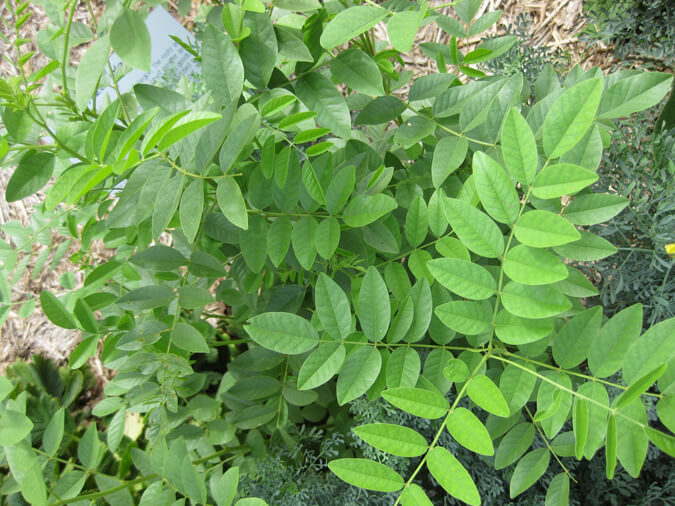
Photo by Raffi Kojian [CC BY-SA 3.0]
Preparation and Usage
The roots, stolons, and rhizomes are the commonly used parts for medicine-making. Leaves can also be used, but are less potent.
Synergize
Licorice is most often used in conjunction with other herbs, due to its synergizing and harmonizing effect. Your options abound in this regard, though one good option is to combine it with Chinese skullcap (Scutellaria baicalensis). Both are broad-spectrum antivirals and help to amplify each other’s effects.95)Buhner, Stephen Harrod. Herbal Antivirals: Natural Remedies for Emerging and Resistant Viral Infections. Pownal, VT: Storey, 2013.
You May Also Enjoy:
“Soothe a Sore Throat With Herbal Ice Cream”
“12 Uses for Rose Petals—From the Kitchen to the Boudoir (With Recipes)”
Softened Licorice Root Slices
While not lollipops in the traditional sense, these sweet, softened licorice roots can be sucked on by children (or adults) with a hoarse throat. Give one once each day to be sucked on for as long as desired. The hoarse throat usually disappears after 2 days.
- (1) 5-inch-long piece of licorice root
- 1 cup water
- 2 tablespoons honey (Omit if using Chinese or cultivated licorice.)
Put all the ingredients in a covered pot and bring to a boil. Reduce heat and simmer for 5 minutes. Strain out the pieces and set them aside. You can keep and drink the liquid, if desired. When cool enough to handle, root pieces can be given to children to suck on.
Tincture
Place dried licorice root in a 40-50% alcohol solution, at a ration of 1 part root to 5 parts alcohol. You my want to add a bit of vinegar to the mixture. Gycyrrhizin is better extracted in a lower-pH environment.
You May Also Enjoy:
Take 1-3 ml 3-6 times daily for gastritis or for the antimicrobial effect.
Note that tinctures do not extract much of the soothing, demulcent properties of licorice.
Decoction
Add 6 grams of powdered licorice root to 16 ounces (or 500 ml) of water and bring it to a moderate boil. Allow it to boil, uncovered, until the liquid volume reduces by half. Then add enough enough water to bring the volume up to 1,000 ml. Drink this throughout the day.
Powder
Licorice powder can be used externally or internally. Externally, you can gently rub the powder onto canker sores and wounds to soothe them and help fight infection. Internally, the powder can be used in teas, in decoctions, or via any of the others methods listed.
Capsules
Divide 4,000 mg into three daily doses. One-half teaspoon of licorice powder is roughly 2,000 mg.
Dental Care
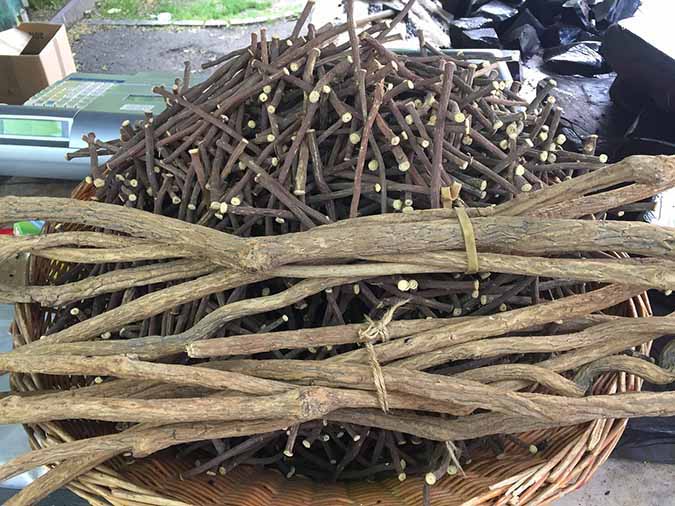
Image by Susanne Hillmer from Pixabay
If you are concerned about taking too much licorice internally, you can still soothe a sore throat and fight microbes in the mouth by using licorice in a mouthwash. Add 1/2 teaspoon of licorice tincture to 1/4 cup water. Swish and gargle with this combination up to 4 times a day.
The whole root can also be fashioned into a toothbrush or into a tooth-cleaning stick.
You May Also Enjoy:
“Equisetum Hyemale (Horsetail): The BEST Plant for Tooth Health + 8 More Benefits!”
“Our 13 Favorite Books About Herbal Medicine”
“How to Make an Electuary: 13+ Tips for Making Delicious Herbal Medicines”
To make a toothbrush, cut away the outer skin on the tip of the root and chew the inner fibers until they spread out like the bristles on a toothbrush. To refresh your toothbrush for future brushings, you can clip the chewed end of the root off and whittle away the outer skin on the next section.
To make a cleaning stick, use a knife to carve a wedge shape and use it to carefully scrape each tooth clean. Use your knife to continue modifying the edge to clean all the tooth surfaces. For detailed instructions on using sticks to clean your teeth, check out “Alternatives to Dentists.”
Precautions and Contraindications
Licorice is generally nontoxic, even in higher doses. However, long-term use is not recommended. Do not use licorice for more than 4-6 weeks without guidance from a medical professional. Blood pressure, potassium levels, and sodium levels should be monitored with extended use.
Lower doses may be safe over a longer time period, but even licorice tea can occasionally cause issues when taken for a period of years.96)Buhner, Stephen Harrod. Herbal Antivirals: Natural Remedies for Emerging and Resistant Viral Infections. Pownal, VT: Storey, 2013.
You May Also Enjoy:
“Homemade Apple Cider Vinegar the Easy Way—With 29 Uses”
Long-term use can cause hypokalemia (potassium depletion), headache, fatigue, dizziness, hypertension, weak limbs, edema, spastic numbness, and potentially heart attack. Very high doses can cause a decrease in body weight, thymus weight, and blood cell count. Symptoms abate after licorice use is discontinued.
Most side effects are linked to the glycyrrhizine in the licorice. Deglycyrrhizinated licorice products can be purchased. These products retain the soothing, demulcent properties of licorice, but lose many of their other properties.
Another way to minimize some side effects is to consume a low-sodium, high-potassium diet while taking licorice.
You May Also Enjoy:
“How to Make Homemade Yogurt: Easy, Inexpensive, and the Healthiest You’ll Ever Eat”
While licorice can be used with children and the elderly, this should be done with due caution.
Large doses should not be used with children. As children usually enjoy the flavor of licorice, you should monitor their intake.
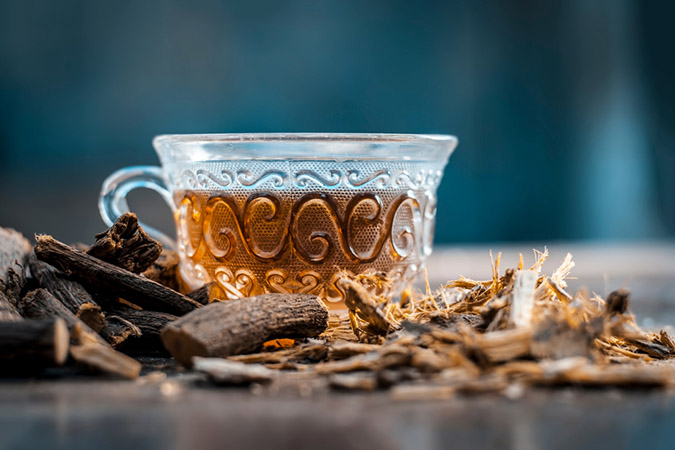
Large and long-term doses are detrimental during pregnancy. Lower doses, such as might be used in a mouthwash, an occasional tea, or combined in low amounts with other herbs, appear to be safe.97)Buhner, Stephen Harrod. Herbal Antivirals: Natural Remedies for Emerging and Resistant Viral Infections. Pownal, VT: Storey, 2013. High doses during lactation should also be avoided. Licorice is contraindicated in cases of hypertension, hypokalemia, hypernatremia, and low testosterone levels. However, low doses in combination with other herbs, over a period of no more than 10 days, should be fairly safe.
Licorice has an estrogenic effect. It can cause breast growth in men. This is especially true if used in high quantities for long periods of time, or with other estrogenic herbs. Like other side effects, this effect will go away after you stop taking the herb.
There is also anecdotal evidence that licorice’s estrogenic effect can impact a woman’s menstrual cycle, potentially lengthening it or causing spotting between cycles.
Due to the highly synergistic nature of licorice, it is not advised to take licorice with estrogenic pharmaceuticals, hypertensive drugs, cardiac glycosides, or diuretics.
How to Identify Licorice
This perennial plant grows up to 6 feet (2 meters) tall and 3 feet (a meter) wide. As a member of the pea family, licorice has several pea-like features. It’s leaves are pinnately compound, 3-6 inches long with 9-17 oval leaflets. The flowers grow in dense racemes and have the typical banner, wings, and keel of a pea family bloom. They can be blue to purple, or yellow with other species.
The roots grow up to 4 inches across and descend as deep as 3 feet (1 meter). Rhizomes spread out from the roots and can emerge as much as 26 feet (8 meters) away from the parent.
You May Also Enjoy:
“Elderberry: Natural Remedy for Colds, the Flu, Inflammation … Even Cancer!”
The inside of the roots is usually yellowish, with wild species being darker.
Several members of the pea family might be considered look-alikes for this plant. Goats rue (Galega officinalis) is possibly the closest. If you are unsure, these two can be differentiated by the stem. Licorice has a solid stem, while goats rue has a hollow one. Licorice also has a burr-like seed pod, which helps to differentiate it from other pea family members.
Where It Grows and Where to Find It
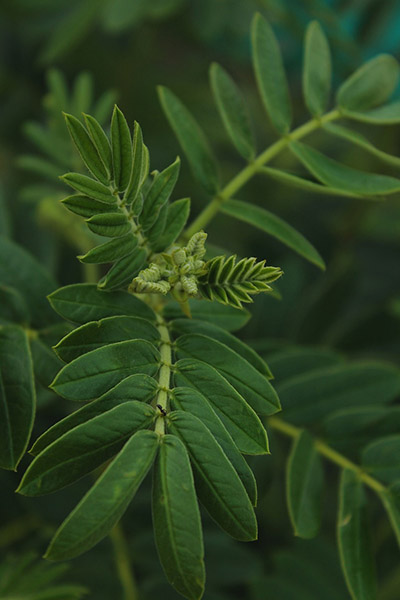
Image by Diego Granados Rosales from Pixabay
Cultivated licorice (Glycyrrhiza glabra) can be found in cultivation, and escaped, in much of the world. Chinese licorice (Glycyrrhiza uralensis) grows wild in southeastern Europe and southwestern Asia. American licorice (Glycyrrhiza lepidota) can be found throughout most of the United States and Canada. You can find some species of licorice nearly everywhere.
Licorice is adapted to many environments, but can often be found along waterways in sandy soil. Many members of the genus prefer wet climates, but others vary and can even be found in semiarid deserts. Representatives of the genus can be found from sea level up to 8,500 feet (2.500 meters).
How and When to Harvest
The roots are typically harvested in autumn, when the concentration of glycyrrhizin is greatest. 3- to 4-year-old roots are preferred, as larger roots have a higher concentration of glycyrrhizin. With Glycyrrhiza uralensis, wait for at least 4-year-old roots, and harvest in mid-summer.
Established licorice plants have a lot of root mass. The amount you can harvest will depend on the age of the plant and how deeply you dig.
A well-established plant could provide a family with medicine indefinitely. It is doubtful that you would ever completely dig out the root system, which would keep the plant coming back year after year.
You May Also Enjoy:
“How to Make Homemade Yogurt: Easy, Inexpensive, and the Healthiest You’ll Ever Eat”
However, spreading out your harvest between plants, with a few years to recover in between, is kinder to the plant.
Licorice can be propagated by root cuttings, allowing you to bring wild plants closer to your home. Once established, they are very hardy and even difficult to get rid of. So think carefully about where to put them. Licorice can also be grown from seed, though this is less reliable.
Licorice is a great-tasting medicine with tons of applications. Whether you use it as a medicine or a flavoring, it has a lot to offer.
What Do You Think?
What are your favorite benefits of licorice? How do you use it, and how has it helped you? Let us know in the comments below!
______________________
Psst! Our Lawyer Wants You to Read This Big, Bad Medical Disclaimer –> The contents of this article, made available via The Grow Network (TGN), are for informational purposes only and do not constitute medical advice; the content is not intended to be a substitute for professional medical advice, diagnosis, or treatment. Always seek the advice of a qualified health care provider with any questions you may have regarding a medical condition. If you think you may be suffering from any medical condition, you should seek immediate medical attention. You should never delay seeking medical advice, disregard medical advice, or discontinue medical treatment because of information provided by TGN. Reliance on any information provided by this article is solely at your own risk. And, of course, never eat a wild plant without first checking with a local expert.
The Grow Network is a participant in the Amazon Services LLC Associates Program, an affiliate program designed to provide a means for our team to earn fees for recommending our favorite products! We may earn a small commission, at no additional cost to you, should you purchase an item after clicking one of our links. Thanks for supporting TGN!

The Grow Network is a global network of people who produce their own food and medicine. We’re the coolest bunch of backyard researchers on Earth! We’re constantly sharing, discovering, and working together to test new paths for sustainable living—while reconnecting with the “old ways” that are slipping away in our modern world. We value soil, water, sunlight, simplicity, sustainability, usefulness, and freedom. We strive to produce, prepare, and preserve our own food and medicine, and we hope you do, too!
References
| ↑1, ↑8, ↑19, ↑22, ↑30, ↑35, ↑46, ↑52, ↑62, ↑67, ↑69, ↑75, ↑84 | Forêt, Rosalee De La. “Licorice Monograph.” HerbMentor. Accessed April 12, 2019. https://herbmentor.learningherbs.com/herb/licorice/. |
|---|---|
| ↑2, ↑7, ↑12, ↑17, ↑21, ↑29, ↑34, ↑51, ↑60, ↑65, ↑74, ↑83 | ”8 Medicinal Ways to Use Licorice Root to Help Fight Stomach Ulcers, Colds and the Flu.” Mercola.com. Accessed April 12, 2019. https://articles.mercola.com/sites/articles/archive/2016/03/21/licorice-root-uses.aspx. |
| ↑3, ↑4, ↑18, ↑24, ↑26, ↑61, ↑66, ↑86, ↑88, ↑93 | Axe, Josh. “Licorice Root Benefits: Adrenal Fatigue, Leaky Gut & More.” Dr. Axe. July 27, 2018. Accessed April 12, 2019. https://draxe.com/licorice-root/. |
| ↑5, ↑10, ↑25, ↑44, ↑45, ↑48, ↑53, ↑54, ↑56, ↑58, ↑68, ↑72, ↑81, ↑85, ↑89, ↑90, ↑92, ↑95, ↑96, ↑97 | Buhner, Stephen Harrod. Herbal Antivirals: Natural Remedies for Emerging and Resistant Viral Infections. Pownal, VT: Storey, 2013. |
| ↑6, ↑11, ↑16, ↑20, ↑23, ↑27, ↑32, ↑36, ↑38, ↑40, ↑42, ↑49, ↑55, ↑59, ↑63, ↑70, ↑73, ↑76, ↑79, ↑82, ↑87, ↑91, ↑94 | Bone, Kerry, and Simon Mills. Principles and Practice of Phytotherapy Modern Herbal Medicine. Edinburgh: Churchill Livingstone, Elsevier, 2013. |
| ↑9, ↑47, ↑57 | Zhou, Jun-Xian, Markus Braun, Pille Wetterauer, Bernhard Wetterauer, and Michael Wink. “Antioxidant, Cytotoxic, and Antimicrobial Activities of Glycyrrhiza Glabra L., Paeonia Lactiflora Pall., and Eriobotrya Japonica (Thunb.) Lindl. Extracts.” Medicines 6, no. 2 (2019): 43. doi:10.3390/medicines6020043. |
| ↑13, ↑31 | Axe, Josh. “Licorice Root Benefits: Adrenal Fatigue, Leaky Gut & More.” Dr. Axe. July 27, 2018. Accessed April 12, 2019. https://draxe.com/licorice-root |
| ↑14 | Forêt, Rosalee De La. “Licorice Monograph.” HerbMentor. Accessed April 12, 2019. https://herbmentor.learningherbs.com/herb/licorice |
| ↑15 | [Buhner, Stephen Harrod. Herbal Antivirals: Natural Remedies for Emerging and Resistant Viral Infections. Pownal, VT: Storey, 2013. |
| ↑28, ↑33, ↑37, ↑39, ↑50, ↑64, ↑71, ↑77 | Hoffmann, David. Medical Herbalism: The Science and Practice of Herbal Medicine. Rochester, VT: Healing Arts Press, 2003. |
| ↑41, ↑78 | Martin, Brett R., Gaurav Reshamwala, and Melanie Short. “Treatment of a Woman With Glycyrrhiza Glabra for Acute Sinusitis: A Case Report.” Journal of Chiropractic Medicine 17, no. 4 (2018): 268-74. doi:10.1016/j.jcm.2018.04.005. |
| ↑43, ↑80 | Fouladi, Saloomeh, Mohsen Masjedi, Mazdak Ganjalikhani Hakemi, and Nahid Eskandari. 2019. “The Review of in Vitro and in Vivo Studies over the Glycyrrhizic Acid As Natural Remedy Option for Treatment of Allergic Asthma”. Iranian Journal of Allergy, Asthma and Immunology18 (1), 1-11. http://ijaai.tums.ac.ir/index.php/ijaai/article/view/1740. |
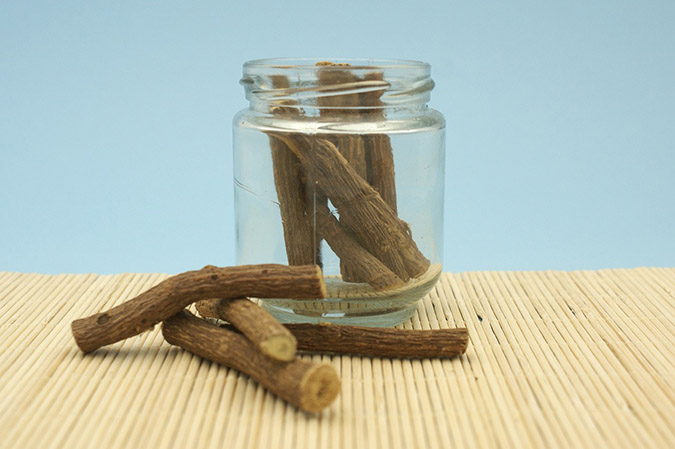
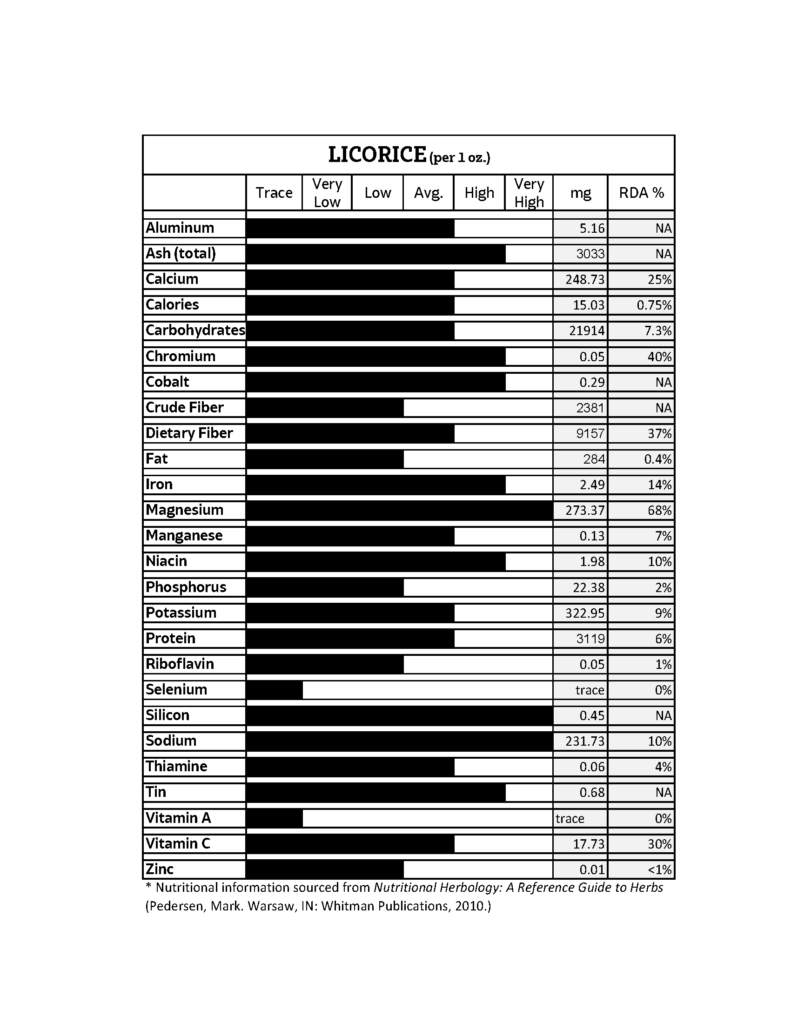
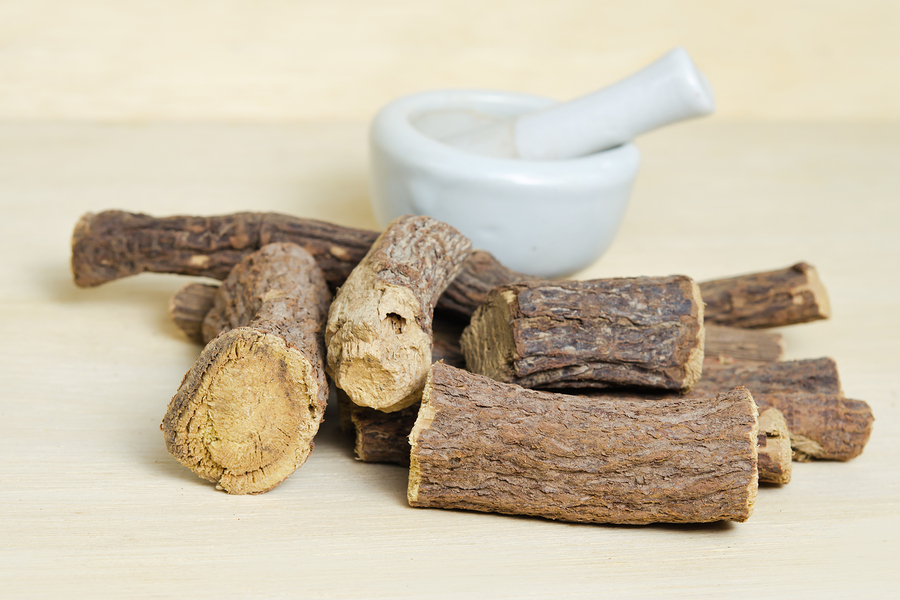
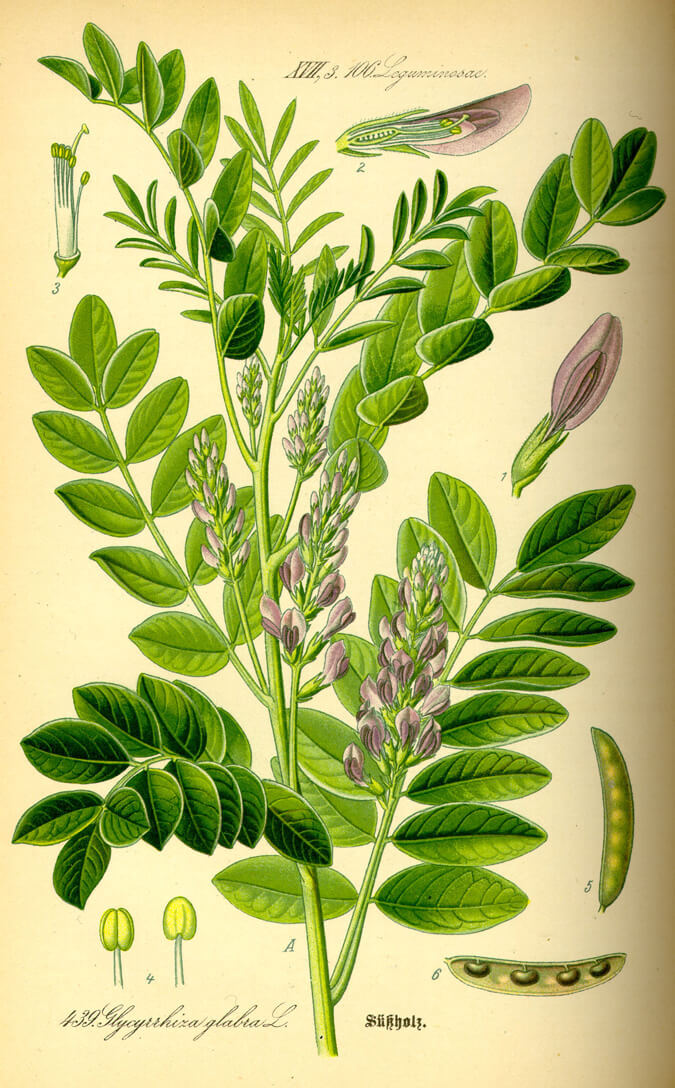







Comments are closed here.